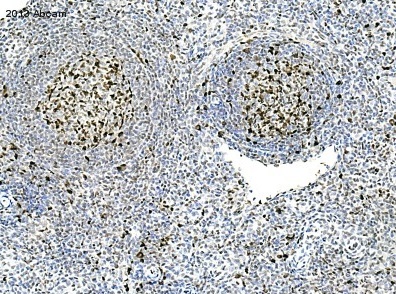
ab18197 staining PCNA in tissue sections of the marmoset spleen by Immunohistochemistry (Formalin/PFA-fixed paraffin-embedded sections). Tissue was fixed with formaldehyde and a heat mediated antigen retrieval step was performed. Samples were then blocked with 1% B.S.A. for 10 minutes at 21ºC followed by incubation with the primary antibody for 2 hours at 1/6000. A biotin-conjugated goat anti-rabbit polyclonal was used as secondary antibody at a 1/250 dilution.See Abreview
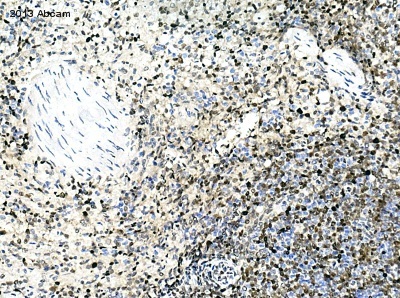
ab18197 staining PCNA in tissue sections of the cow spleen by Immunohistochemistry (Formalin/PFA-fixed paraffin-embedded sections). Tissue was fixed with formaldehyde and a heat mediated antigen retrieval step was performed. Samples were then blocked with 1% B.S.A. for 10 minutes at 21ºC followed by incubation with the primary antibody for 2 hours at 1/4000. A biotin-conjugated goat anti-rabbit polyclonal was used as secondary antibody at a 1/250 dilution.See Abreview
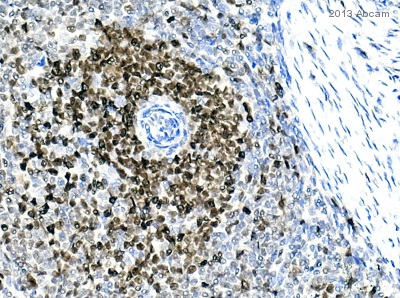
ab18197 staining PCNA in tissue sections of the goat spleen by Immunohistochemistry (Formalin/PFA-fixed paraffin-embedded sections). Tissue was fixed with formaldehyde and a heat mediated antigen retrieval step was performed. Samples were then blocked with 1% B.S.A. for 10 minutes at 21ºC followed by incubation with the primary antibody for 2 hours at 1/4000. A biotin-conjugated goat anti-rabbit polyclonal was used as secondary antibody at a 1/250 dilution.See Abreview
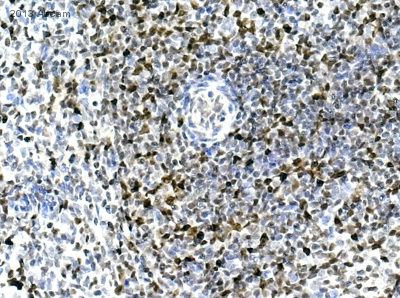
ab18197 staining PCNA in tissue sections of the sheep spleen by Immunohistochemistry (Formalin/PFA-fixed paraffin-embedded sections). Tissue was fixed with formaldehyde and a heat mediated antigen retrieval step was performed. Samples were then blocked with 1% B.S.A. for 10 minutes at 21ºC followed by incubation with the primary antibody for 2 hours at 1/6000. A biotin-conjugated goat anti-rabbit polyclonal was used as secondary antibody at a 1/250 dilution.See Abreview
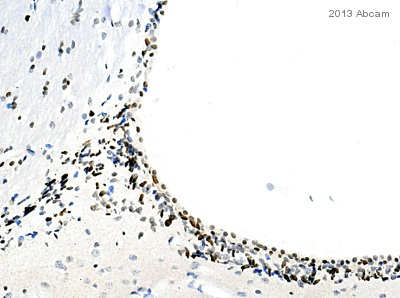
ab18197 staining PCNA in tissue sections of the rat brain by Immunohistochemistry (Formalin/PFA-fixed paraffin-embedded sections). Tissue was fixed with formaldehyde and a heat mediated antigen retrieval step was performed. Samples were then blocked with 1% B.S.A. for 10 minutes at 21ºC followed by incubation with the primary antibody for 2 hours at 1/10000. A biotin-conjugated goat anti-rabbit polyclonal was used as secondary antibody at a 1/250 dilution.See Abreview
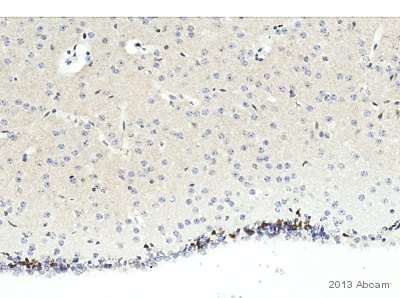
ab18197 staining PCNA in tissue sections of the mouse brain by Immunohistochemistry (Formalin/PFA-fixed paraffin-embedded sections). Tissue was fixed with formaldehyde and a heat mediated antigen retrieval step was performed. Samples were then blocked with 1% B.S.A. for 10 minutes at 21ºC followed by incubation with the primary antibody for 2 hours at 1/6000. A biotin-conjugated goat anti-rabbit polyclonal was used as secondary antibody at a 1/250 dilution.See Abreview
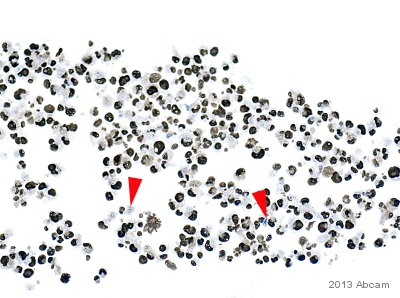
ab18197 staining PCNA in Monkey COS cell pellet by Immunohistochemistry (Formalin/PFA-fixed paraffin-embedded sections). Tissue was fixed with formaldehyde and a heat mediated antigen retrieval step was performed. Samples were then blocked with 1% B.S.A. for 10 minutes at 21ºC followed by incubation with the primary antibody for 2 hours at 1/4000. A biotin-conjugated goat anti-rabbit polyclonal was used as secondary antibody at a 1/250 dilution.See Abreview
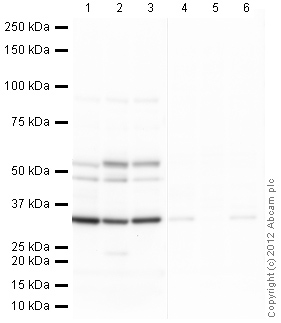
All lanes : Anti-PCNA antibody (ab18197) at 1 µg/mlLane 1 : HEK293 (Human embryonic kidney cell line) Whole Cell LysateLane 2 : NIH 3T3 (Mouse embryonic fibroblast cell line) Whole Cell LysateLane 3 : PC12 (Rat adrenal pheochromocytoma cell line) Whole Cell LysateLane 4 : HEK293 (Human embryonic kidney cell line) Whole Cell Lysate with Human PCNA peptide (ab18602) at 1 µg/mlLane 5 : NIH 3T3 (Mouse embryonic fibroblast cell line) Whole Cell Lysate with Human PCNA peptide (ab18602) at 1 µg/mlLane 6 : PC12 (Rat adrenal pheochromocytoma cell line) Whole Cell Lysate with Human PCNA peptide (ab18602) at 1 µg/mlLysates/proteins at 20 µg per lane.SecondaryGoat Anti-Rabbit IgG H&L (HRP) preadsorbed (ab97080) at 1/5000 dilutiondeveloped using the ECL techniquePerformed under reducing conditions.
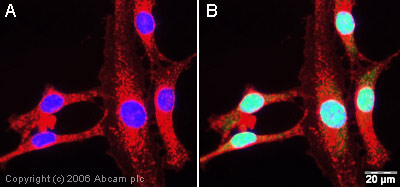
ICC/IF image of ab18197 stained NIH/3T3 cells. The cells were methanol fixed (5 min) and incubated with the antibody (ab18197, 1µg/ml) for 1h at room temperature. The secondary antibody (green) was Alexa Fluor® 488 goat anti-rabbit IgG (H+L) used at a 1/1000 dilution for 1h. Image-iTTM FX Signal Enhancer was used as the primary blocking agent, 5% BSA (in TBS-T) was used for all other blocking steps. DAPI was used to stain the cell nuclei (blue). Alexa Fluor® 594 WGA was used to label plasma membranes (red). Panel A does not show the Alexa Fluor® 488 channel, Panel B shows the specfic nuclear staining by ab18197.

ab18197, at a 1/5000 dilution, staining PCNA in assynchronous HeLa cells. Cells were counter-stained with DAPI (red). For more information please refer to Abreview.See Abreview

ab18197, at a 1/2000 dilution staining PCNA in MRC5 Sv40 transformed fibroblasts. Cells were counterstained with DAPI (blue). For more information please refer to Abreview.See Abreview

ab18197 staining rat PC12 whole cell lysate by Immunoprecipitation. ab18197 was incubated with the lysate (at a concentration of 5µg/ml) and a Protein A matrix for 12 hours at 4°C to achieve immunoprecipitation. 400µg of protein were present in the lysate input.Lane order: PCNA IP (lane 1), Control IP (lane 2), Input 5% (lane 3)This antibody immunoprecipitates a product of ~34 kDa which is consistent with the mobility of PCNA on SDS-PAGEab18197 was also used for the western blot step, at a contration of 1µg/mlSee Abreview

ab18197 staining PCNA in Zebrafish gastrula embryos by Immunocytochemistry/ Immunofluorescence (wholemount).Zebrafish embryos were fixed overnight at 4°C when they had reached 60% epiboly. Cells were fixed in formaldehyde, permeabilized using Proteinase K, blocked with 2% goat serum for 2 hours at 20°C and then incubated with ab18197 at a 1/500 dilution for 16 hours at 4°C. The secondary used was an Alexa-Fluor 488 conjugated goat anti-rabbit polyclonal used at a 1/500 dilution. Cells were post-fixed in PFA for 20 minutes at room temperature after extensive washing of the secondary antibody.The left panel shows DAPI stained nuclei, the center panel is PCNA staining, and the right panel is the merged image.See Abreview
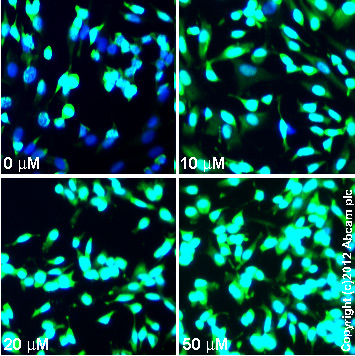
ab18197 staining PCNA in SK-N-SH cells treated with KN-62 (ab120421), by ICC/IF. Increase in PCNA nuclear expression correlates with increased concentration of KN-62, as described in literature.The cells were incubated at 37øC for 24h in media containing different concentrations of ab120421 (KN-62) in DMSO, fixed with 100% methanol for 5 minutes at -20øC and blocked with PBS containing 10% goat serum, 0.3 M glycine, 1% BSA and 0.1% tween for 2h at room temperature. Staining of the treated cells with ab18197 (1 æg/ml) was performed overnight at 4øC in PBS containing 1% BSA and 0.1% tween. A DyLight 488 goat anti-rabbit polyclonal antibody (ab96899) at 1/250 dilution was used as the secondary antibody. Nuclei were counterstained with DAPI and are shown in blue.
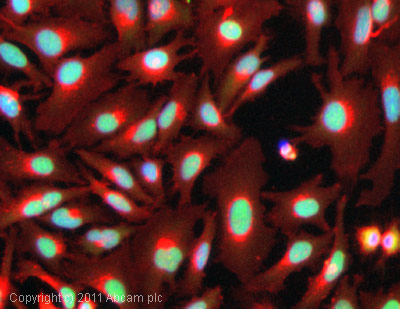
ICC/IF image of ab18197 stained Hela cells. The cells were 100% methanol fixed (5 min) and then incubated in 1%BSA / 10% normal goat serum / 0.3M glycine in 0.1% PBS-Tween for 1h to permeabilise the cells and block non-specific protein-protein interactions. The cells were then incubated with the antibody (ab18197, 1µg/ml) overnight at +4°C. The secondary antibody (green) was DyLight® 488 goat anti-rabbit IgG - H&L, pre-adsorbed (ab96899) used at a 1/250 dilution for 1h. Alexa Fluor® 594 WGA was used to label plasma membranes (red) at a 1/200 dilution for 1h. DAPI was used to stain the cell nuclei (blue) at a concentration of 1.43µM.
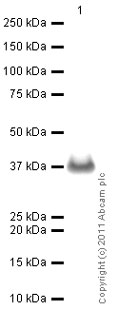
developed using the ECL techniquePerformed under reducing conditions.
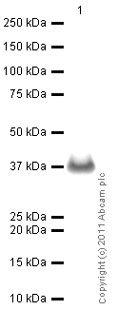
developed using the ECL techniquePerformed under reducing conditions.
















